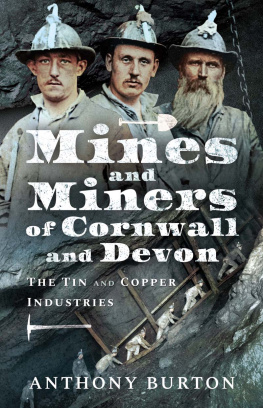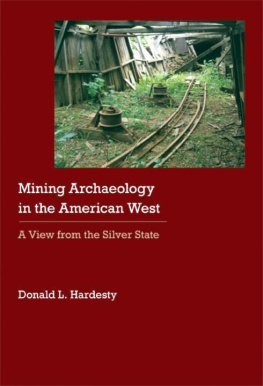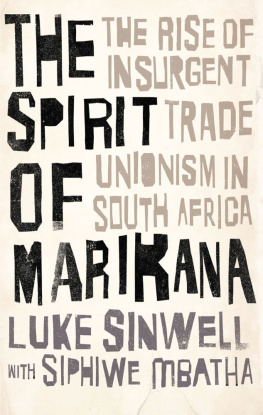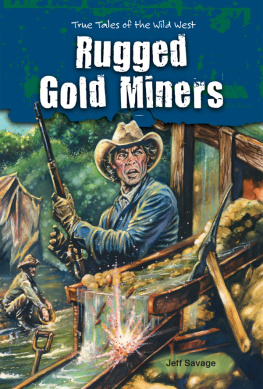African History Archive
Over the past forty years, Zed has established a long and proud tradition of publishing critical work on African issues, offering unique insights into the continents politics, development, history and culture. The African History Archive draws on this rich backlist, consisting of carefully selected titles that even now have enduring relevance years after their initial publication. Lovingly repackaged, with newly commissioned forewords that reflect on the impact the books have had, these are essential works for anyone interested in the political history of the continent.
Other titles in the archive:
A History of Africa
Hosea Jaffe
No Fist Is Big Enough to Hide the Sky: The Liberation of Guinea-Bissau and Cape Verde, 196374
Basil Davidson
Yours for the Union: Class and Community Struggles in South Africa
Baruch Hirson
The Story of an African Working Class: Ghanaian Miners Struggles
18701980 was first published in 1984 by Zed Books Ltd,
The Foundry, 17 Oval Way, London SE11 5RR, UK
This ebook edition was first published in 2017
www.zedbooks.net
Copyright Jeff Crisp 1984
The right of Jeff Crisp to be identified as the editor of this work
has been asserted by her in accordance with the Copyright,
Designs and Patents Act, 1988
Cover design: Kika Sroka-Miller
All rights reserved. No part of this publication may be reproduced,
stored in a retrieval system or transmitted in any form or by any
means, electronic, mechanical, photocopying or otherwise,
without the prior permission of Zed Books Ltd.
A catalogue record for this book is available from the British Library
ISBN 978-1-78699-067-9 hb
ISBN 978-1-78360-976-5 pb
ISBN 978-1-78360-975-8 pdf
ISBN 978-1-78360-973-4 epub
ISBN 978-1-78360-974-1 mobi
FOREWORD BY GAVIN HILSON
Jeff Crisps book, The Story of an African Working Class , offers invaluable analysis of the labour dynamics and organizational structures in Ghanas mining sector over 110 years spanning the countrys colonial period and independence from Great Britain. The text focuses heavily on labour control, capturing the essence of the day-to-day struggles faced by indigenous mine workers during this time. It explains how, through strikes, unions and informal forms of resistance, indigenous workers challenged authority in a bid to improve their quality of life. The book has attracted some criticism over the years, but for the most part it has been acclaimed for its accurate and detailed description of Ghanas mining sector during this period, its strong historical narrative and its Marxist lens. It, along with Peter Greenhalghs West African Diamonds, 1919-1983: An Economic History , are today regarded as the two landmark texts on Ghanas mining history.
Over the years, the book has catalysed scholarly interest in, and research on, the mining sector in Ghana. At the time of its publication, there was already an impressive body of work in circulation on mining in Southern Africa, headlined by contributions from scholars such as Robert Kubicek, Frederick Johnstone, Ian Phimister and Charles Van Onselen. Most of this work was also Marxist in tone, chronicling the rise of mining and the organization of its operations and labour in the Witwatersrand, and Northern and Southern Rhodesia. The Story of an African Working Class was instrumental in bringing into the spotlight Ghanas equally rich and turbulent mining history. At approximately the same time the first rough diamonds were being harvested in Kimberley, South Africa, the foundations for present-day Ghanas first industrial-scale gold mines were being laid. Jeff Crisp captures these details through extensive research, including a detailed analysis of well-preserved documents contained in the countrys National Archives. These documents would provide the bedrock for more recent seminal publications on mining in Ghana, which Jeff Crisps work no doubt helped to inspire. Notable among these is Don Robothams Mining or Proletarians? The Economic Culture of Underground Miners in Southern Ghana, 19061976 and Raymond Dumetts El Dorado in West Africa: The Gold-Mining Frontier, African Labor and Colonial Capitalism in the Gold Coast, 18751900 .
In recent years, however, The Story of an African Working Class has taken on additional significance: offering a glimpse of how mines should perform in marked the end of the particular period in Ghanas mining industry on which the book focuses.
Of course, the author had no idea that this would happen. In 1981, Flight Lieutenant Jerry Rawlings seized control of the Ghanaian state, removing Dr Hilla Limann, whom he had installed as president, following a successful coup dtat, in 1979. Rawlings brought political stability to Ghana, which has since had six elections and is today championed as a beacon of democracy in Africa. But during Rawlings twelve years as Ghanas president, the countrys mining sector experienced unprecedented change. Coincidentally, in 1983, the year in which The Story of an African Working Class was published, Ghana implemented its ambitious IMF-endorsed Economic Recovery Program, a move aimed at stabilizing the countrys economy, and which would provide the bedrock for a series of World Bank-funded structural adjustment programs. Mining sector reforms aimed at attracting foreign investment in the sector were implemented alongside these programs, culminating in the passing of a new piece of legislation, The Minerals and Mining Law (PNCL 153), in 1986. As with all industries in Africa, globalization would forever change the face of the continents mining sector.
In their book, Africa Undermined (1979), Greg Lanning and Marti Mueller, drawing on experiences from Zambia, Zimbabwe and the Democratic Republic of Congo, would cast light on the brand of development a liberalized mining sector, populated and controlled by foreign multinationals, would bring to Africa. In Ghana, this manifested as a rapid, and at times hostile, acquisition of rights in localities such as Prestea and Tarwka, as well as the closing down of the State Gold Mining Corporations operations in the towns of Bibiani and Konongo. Today, Ghana boasts the tenth-largest gold mining economy in the world, and the second largest in Africa. It is, however, a very different industry to that which Jeff Crisp studied so meticulously and reported on extensively. Alongside a series of large-scale mining enclaves and innumerable mineral exploration activities, there is a burgeoning artisanal and small-scale segment populated by hundreds of thousands of men and women, many of whom once worked at the sites now closed or under private ownership which the author details in his book.









